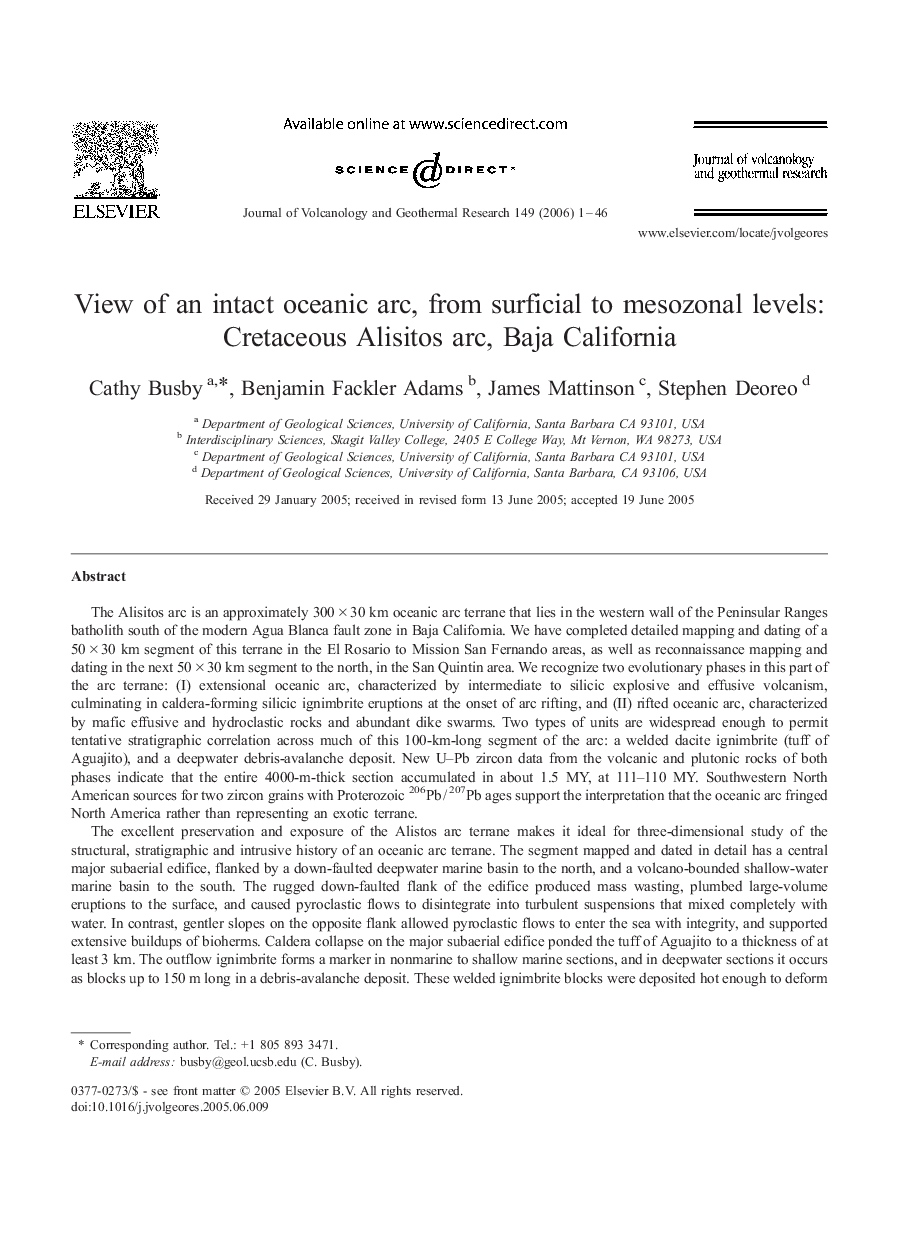| کد مقاله | کد نشریه | سال انتشار | مقاله انگلیسی | نسخه تمام متن |
|---|---|---|---|---|
| 4714924 | 1638487 | 2006 | 46 صفحه PDF | دانلود رایگان |

The Alisitos arc is an approximately 300 × 30 km oceanic arc terrane that lies in the western wall of the Peninsular Ranges batholith south of the modern Agua Blanca fault zone in Baja California. We have completed detailed mapping and dating of a 50 × 30 km segment of this terrane in the El Rosario to Mission San Fernando areas, as well as reconnaissance mapping and dating in the next 50 × 30 km segment to the north, in the San Quintin area. We recognize two evolutionary phases in this part of the arc terrane: (I) extensional oceanic arc, characterized by intermediate to silicic explosive and effusive volcanism, culminating in caldera-forming silicic ignimbrite eruptions at the onset of arc rifting, and (II) rifted oceanic arc, characterized by mafic effusive and hydroclastic rocks and abundant dike swarms. Two types of units are widespread enough to permit tentative stratigraphic correlation across much of this 100-km-long segment of the arc: a welded dacite ignimbrite (tuff of Aguajito), and a deepwater debris-avalanche deposit. New U–Pb zircon data from the volcanic and plutonic rocks of both phases indicate that the entire 4000-m-thick section accumulated in about 1.5 MY, at 111–110 MY. Southwestern North American sources for two zircon grains with Proterozoic 206Pb / 207Pb ages support the interpretation that the oceanic arc fringed North America rather than representing an exotic terrane.The excellent preservation and exposure of the Alistos arc terrane makes it ideal for three-dimensional study of the structural, stratigraphic and intrusive history of an oceanic arc terrane. The segment mapped and dated in detail has a central major subaerial edifice, flanked by a down-faulted deepwater marine basin to the north, and a volcano-bounded shallow-water marine basin to the south. The rugged down-faulted flank of the edifice produced mass wasting, plumbed large-volume eruptions to the surface, and caused pyroclastic flows to disintegrate into turbulent suspensions that mixed completely with water. In contrast, gentler slopes on the opposite flank allowed pyroclastic flows to enter the sea with integrity, and supported extensive buildups of bioherms. Caldera collapse on the major subaerial edifice ponded the tuff of Aguajito to a thickness of at least 3 km. The outflow ignimbrite forms a marker in nonmarine to shallow marine sections, and in deepwater sections it occurs as blocks up to 150 m long in a debris-avalanche deposit. These welded ignimbrite blocks were deposited hot enough to deform plastically and form peperite with the debris-avalanche matrix. The debris avalanche was likely triggered by injection of feeder dikes along the basin-bounding fault zone during the caldera-forming eruption.Intra-arc extension controlled very high subsidence rates, followed shortly thereafter by accretion through back-arc basin closure by 105 Ma. Accretion of the oceanic arc may have been accomplished by detachment of the upper crust along a still hot, thick middle crustal tonalitic layer, during subduction of mafic–ultramafic substrate.
Journal: Journal of Volcanology and Geothermal Research - Volume 149, Issues 1–2, 1 January 2006, Pages 1–46